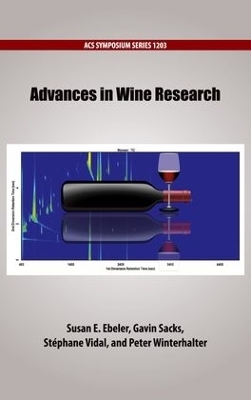
Advances in Wine Research
Oxford University Press Inc (Verlag)
978-0-8412-3010-1 (ISBN)
The complexity of wine provides numerous avenues of discovery for food and analytical chemists. This volume begins with an overview of advances in the analytical techniques used for grape and wine research, including chromatographic and mass spectrometric tools for understanding chemistry of volatiles, nonvolatiles and inorganic components of grapes and wines. Recent advances in flavor chemistry are highlighted in the second section of this book, as well as the
latest NMR techniques for monitoring diffusion of carbon dioxide bubbles in sparkling wines and the utilization of oxidation chemistry during wine processing. The last section of this volume focuses on the intersection of grape and wine chemistry with sustainable production practices, reflecting the
increasing scientific interest in byproduct utilization and global and environmental stewardship.
Susan Ebeler is a professor in the Department of Viticulture and Enology at the University of California, Davis. Her research is focused on development and application of analytical chemistry techniques to study flavor chemistry and the physic-chemical interactions of flavors with nonvolatile wine components. At UC Davis, she teaches undergraduate and graduate classes on the analysis of grapes and wines as well as the flavor chemistry of foods and beverages. She is also co-director of the UC Davis Food Safety and Measurement Facility. Gavin Sacks is an Associate Professor in Food Science at Cornell University, where he has been a faculty member since 2007. He received his B.S. in Chemistry from the University of Virginia and his M.S. and Ph.D. in Chemistry from Cornell University. Stéphane Vidal joined Nomacorc in 2007 and is the global director of enology leading a team in charge of Nomacorc's initiatives on oxygen management support and solutions. Stéphane is a biochemist engineer from the Institut National des Sciences Appliquées in Lyon, France. He received his master's degree from Université Claude Bernard in Lyon, France and his Ph.D. from Université Joseph Fourier in Grenoble, France. Peter Winterhalter is head of the Institute of Food Chemistry at the Technische Universität Braunschweig (TUBS), Germany. He graduated from the University of Karlsruhe and obtained his Ph.D. from Würzburg University in 1988. In 1989 he worked as a postdoctoral fellow at the Australian Wine Research Institute, Adelaide, before returning to Würzburg University as a Research Fellow. In 1995, he was appointed as Professor of Food Chemistry at the University of Erlangen-Nürnberg before finally moving to TUBS where he was dean of the Faculty of Chemistry and Pharmacy.
Preface
Analytical Chemistry for Wine Research
1. Analysis of Grapes and Wines: An Overview of New Approaches and Analytical Tools
2. Combined Nontargeted Analytical Methodologies for the Characterization of the Chemical Evolution of Bottled Wines
3. Influence of Storage Conditions on the Composition of Red Wines
4. Gas Detection Tubes for Measurement of Molecular and Free SO2 in Wine
5. Temperature Dependence of CO2 and Ethanol Diffusion in Champagne Wines: A Joint Molecular Dynamics and 13C NMR Study
6. Authentication of Wine by 1H-NMR Spectroscopy: Opportunities and Challenges
7. Effect of Region on the Volatile Composition and Sensory Profiles ofMalbec and Cabernet Sauvignon Wines
8. Model Study on Changes in Key Aroma Compounds of Dornfelder Red Wine Induced by Treatment with Toasted French Oak Chips (Q. robur)
9. Terroir Effects on Grape and Wine Aroma Compounds
10. C13-Norisoprenoids in Grape and Wine Affected by Different Canopy Management
11. Under-Vine Management To Modulate Wine Chemical Profile
12. Induction of de Novo Mono- and Sesquiterpene Biosynthesis by Methyl Jasmonate in Grape Berry Exocarp
Understanding the Influence of Oxygen on Wine Quality
13. Critical Oxygen Levels Affecting Wine Aroma: Relevant Sensory Attributes, Related Aroma Compounds, and Possible Mechanisms
14. Influence of Antioxidant Additions at Harvest on Sauvignon Blanc Wine Aroma
15. New Insights into Intrinsic and Extrinsic Factors Triggering Premature Aging in White Wines
16. Evolution of Anthocyanin-Derived Compounds during Micro-Oxygenation of Red Wines with Different Anthocyanin-Flavanol Ratios
17. New Insights into the Chemistry Involved in Aroma Development during Wine Bottle Aging: Slow Redox Processes and Chemical Equilibrium Shifts
18. Quinone Reactions in Wine Oxidation
19. Photodegradation of Organic Acids in a Model Wine System Containing Iron
20. Oxidation Signature of Grape Must and Wine by Linear Sweep
Utilization of Byproducts and Sustainable Production Practices
21. Bioactives from Side Streams of Wine Processing
22. Evaluation of the Potential of Grape Canes as a Source of Bioactive Stilbenoids
23. Objective Chemical Measures of Grape Quality
24. Paired Potassium-Based Buffers for Sanitizing Winery Equipment and the Carbon, Nitrogen, Sodium, and Phosphorus Footprints of Winery Cleaning
| Erscheinungsdatum | 23.08.2016 |
|---|---|
| Reihe/Serie | ACS Symposium Series |
| Zusatzinfo | 81 |
| Verlagsort | New York |
| Sprache | englisch |
| Maße | 158 x 233 mm |
| Gewicht | 718 g |
| Themenwelt | Naturwissenschaften ► Chemie ► Analytische Chemie |
| Technik ► Lebensmitteltechnologie | |
| Technik ► Umwelttechnik / Biotechnologie | |
| Weitere Fachgebiete ► Land- / Forstwirtschaft / Fischerei | |
| ISBN-10 | 0-8412-3010-2 / 0841230102 |
| ISBN-13 | 978-0-8412-3010-1 / 9780841230101 |
| Zustand | Neuware |
| Haben Sie eine Frage zum Produkt? |
aus dem Bereich


